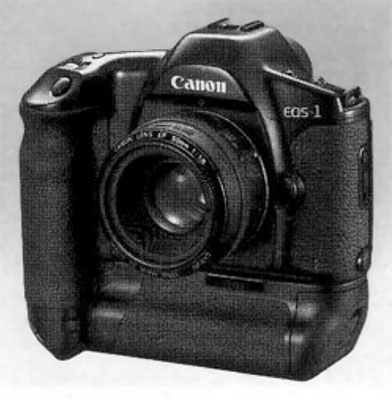25 years of pro goodness: Canon marks a major milestone for the EOS 1-series
posted Wednesday, June 11, 2014 at 10:38 AM EST

Canon fans, are you ready to party? The company is celebrating a milestone for its EOS-1 series of professional SLRs, and it's a pretty impressive one. The original EOS-1 film SLR hit the market all the way back in 1989, so the series has now been on sale for a quarter-century!
What's really impressive to us, though, is just how far we've come. Although it was quite the camera for its day, the EOS-1 of all those years ago is in many respects surpassed by the enthusiast DSLRs of today. In fact, even Canon's entry-level Rebel cameras better it in some respects -- and yet are far more compact, and weigh just half as much, despite all the electronics crammed inside a modern DSLR. And the high-water mark of professional DSLRs these days is simply in a different league.
When it hit the market in September 1989, some two years after the EOS brand debuted with the Canon EOS 650, the EOS-1 was priced at ¥189,000. At the exchange rates of the time (and taking into account US dollar inflation), that's about US$2,500 in today's money. For that, you got a burst-shooting rate of just 2.5 frames per second, a six-zone metering sensor and a single autofocus point. A simultaneously-released (but even bulkier and more expensive) EOS-1 HS variant allowed 5.5 frames-per-second shooting courtesy of a dedicated Power Drive Booster pack, but cost around US$3,200 and needed eight AA batteries as a power source.

Today, the most affordable Canon DSLR is the Rebel T3, with a list price of just US$450 including a lens -- and yet it's faster, and sports much more sophisticated autofocus and metering systems. (The burst-capture rate is 3.0 frames per second, exposures are determined with a 63-zone metering system, and there are nine autofocus points.) And while it's not weather-sealed like the EOS-1, construction is actually similar. Unlike pro cameras today, the EOS-1 had a polycarbonate body over a steel chassis, just as do the Rebel series today.
As well as lacking the EOS-1's rugged nature, today's Rebels also forgo its twin control dials, 100% pentaprism viewfinder, and swift 1/8,000-second top shutter speed, of course. But all these and more can be found in modern enthusiast cameras like the EOS 7D, and at only half the equivalent cost of an EOS-1 back in the 1980s. And of course, today's DSLRs include a sensor, processor, and all the other electronics necessary to shoot hundreds of thousands of frames at no more cost than the power taken to recharge the batteries. The EOS-1, by contrast, required endless film and processing, making it an even more expensive proposition.

The most incredible comparison is to a modern professional DSLR like the Canon EOS-1D X. Sure, that camera lists for around twice as much as you'd have paid for an EOS-1 HS back in the day, before you account for the cost of film and processing. It raises the bar so far beyond what was possible back in 1989 that the increased price seems quite reasonable, though. Instead of one autofocus point, there are 61. The six-segment metering sensor is replaced with a 100,000 pixel RGB metering sensor that operates using 252 zones. Where the EOS-1 HS could capture 5.5 frames per second, the EOS-1D X will manage up to 14 frames. And while it's a little larger and quite a lot heavier than an EOS-1, your 1D X will also double as a high-definition video camera, effectively providing two cameras for the price (and bulk) of one.
So celebrate, Canon fans. Not only is a quarter-century of EOS-1 professional cameras quite the milestone to look back upon, but it's also a great time to be a photographer. Cameras today are so much more powerful and affordable than those of two or three decades ago that it makes our heads spin -- and we'll happily raise a glass to that!
